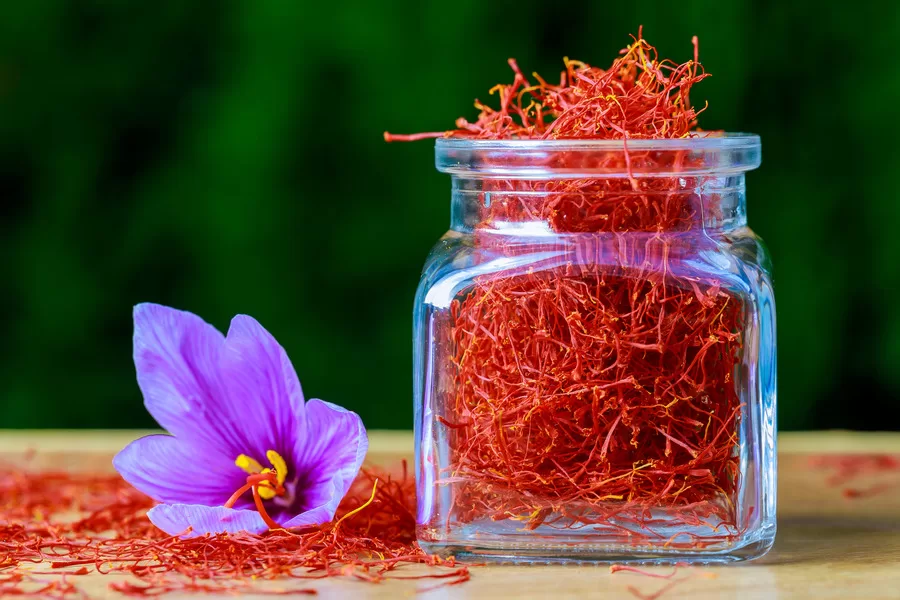
This narrative doesn’t dwell in the annals of the past but flourishes in the present, spotlighting saffron, a treasure derived from the tender blossoms of Crocus sativus. Beyond its role in elevating the gastronomic experience, saffron emerges as a beacon of health, championing weight management and emotional wellness with its rich, aromatic threads.
Are you ready to explore the luxurious and healthful virtues hidden within the world’s most sought-after spice?
Saffron
Saffron, a spice sourced from the delicate Crocus sativus bloom, holds a revered place not just in culinary realms but also in the annals of herbal medicine. Its rich hue and distinctive taste have been celebrated across ages, but it’s the painstaking process of cultivation that sets it apart as one of the planet’s most prized spices. Imagine, over 75,000 blossoms are needed to gather a mere pound of saffron threads, each picked by hand from the flower’s core, showcasing the immense labor and care invested in its production.
Unlocking Saffron’s Secrets
What elevates saffron beyond its culinary allure are the powerful elements it harbors, capable of influencing weight control efforts. Key components such as crocin, picrocrocin, and safranal endow saffron with its signature color, taste, and scent, and are pivotal to its health-enhancing attributes. These include mood elevation and suppression of the urge to eat, positioning saffron as a natural ally in the quest for weight reduction.
A Historical Panacea
Tracing back through time, saffron has been esteemed for its therapeutic qualities, offering remedies for ailments from indigestion to melancholy across diverse cultures. This global treasure was as much a staple in the healing kits of ancient Middle East practitioners as it was in the medicine chests of European royalty during the medieval era. Contemporary research is now shedding light on how the spice’s complex chemistry supports both mental and physical well-being, with a notable emphasis on its potential to assist in managing weight.
Nature’s Appetite Moderator
The capacity of saffron to subtly reduce hunger stands out, offering a gentler alternative to harsh chemical suppressants. This natural method aids in curtailing emotional eating, a common hurdle in weight loss journeys, by fostering a brighter mood and diminishing the inclination for stress-induced snacking. The link between a buoyant emotional state and decreased cravings for sugary or high-fat foods is crucial for sustainable weight management.
Antioxidant Powerhouse
Beyond mood improvement, the antioxidants in saffron may play a role in enhancing metabolic health, though this area invites further exploration. These antioxidants combat oxidative stress and could pave the way for improved metabolic rates, an essential factor in the weight loss equation.
Exploring the depths of saffron’s contributions to both gourmet dishes and health remedies unveils the natural world’s capability to support our well-being. This luxurious spice, esteemed for centuries, continues to offer its bounty in aiding modern-day health challenges, including the pursuit of a balanced weight.
Exploring the Weight Loss Synergy with Saffron
At the heart of saffron’s connection to weight management lie its dynamic compounds, crocin and safranal. These naturally occurring elements are thought to directly affect one’s mood and appetite regulation, potentially leading to a more controlled consumption of calories and a noticeable decrease in the habit of snacking.
Enhanced Appetite Regulation
Saffron’s capacity to diminish appetite stands out as a key benefit in the context of weight loss. This spice’s mood-enhancing properties are believed to play a significant role in reducing the frequency of snacking, especially among individuals who tend to snack out of habit. Intriguingly, a study featured in Nutrition Research has shown that women who supplemented their diet with saffron extract reported a decrease in snack consumption and experienced more weight loss compared to their counterparts who did not use the supplement. This evidence points towards the potential of saffron as an effective tool in managing dietary habits more efficiently.
Mood Enhancement and Emotional Eating
Combatting emotional eating—a common challenge in weight management—is another area where saffron shows promise. The spice’s potential to act as an antidepressant, primarily through the modulation of serotonin levels facilitated by crocin and safranal, may help in curbing the inclination towards comfort eating. By uplifting one’s mood, saffron could play a crucial role in fostering healthier dietary choices, steering individuals away from the pitfalls of emotional eating.
Metabolic Enhancement Possibilities
The potential impact of saffron on metabolic rate is a topic of ongoing exploration. An efficient metabolism is fundamental to the process of calorie burning, a critical factor in weight reduction efforts. There is speculation that saffron may have properties that boost metabolic activity, thus aiding the body in more effectively burning calories. While conclusive evidence is yet to emerge, this prospect adds to the intrigue surrounding saffron’s potential as a weight management aid.
The incorporation of saffron into one’s dietary regime is not merely about enriching the flavor profile of dishes; it’s about leveraging its mood-enhancing and appetite-regulating benefits to address one of the most complex elements of weight loss—dietary discipline. As research continues to shed light on saffron’s impact on the body, it’s becoming increasingly apparent that this spice could serve as a valuable companion in the journey towards a healthier weight. Nevertheless, achieving weight loss is a multifaceted endeavor that should encompass a balanced diet, consistent physical activity, and overall psychological well-being, with saffron acting as a complementary support in this integrated approach.
Infusing Your Diet with the Golden Spice
Delight in Golden Tea
One of the simplest pleasures can be found in preparing a warm cup of tea infused with this golden thread. Ideal for those times you seek something both comforting and light, this tea requires only a few threads steeped in boiling water for about five minutes. Enhancements like lemon slice, a dash of cinnamon, or a dollop of honey can add complexity to the flavor. This fragrant beverage not only pleases the palate but also taps into the mood-lifting and hunger-reducing effects of the spice.
Gourmet Cooking with a Golden Touch
The distinctive taste of this spice makes it an extraordinary addition to a wide array of dishes, transforming simple ingredients into sumptuous meals without contributing excess calories. Consider the following uses to elevate your cooking:
- Golden Risottos: A touch of this spice in risotto not only bestows the dish with a rich hue but also imparts a flavor that is both sophisticated and comforting.
- Enhanced Soups: A sprinkle in various soups can elevate the flavor profile, from smooth bisques to robust vegetable broths, enriching them with its unique aroma and essence.
- Luxurious Seafood: It pairs exceptionally well with seafood, adding depth to paella, stews, and grilled fish dishes with its subtle yet impactful taste.
By experimenting with this spice in your culinary endeavors, you not only enrich the dish’s health quotient but also elevate everyday meals into gastronomic delights.
Convenient Supplementation
For individuals seeking to gain the benefits of this spice without significantly changing their culinary routines, opting for dietary supplements can be a practical choice. These are offered in forms like capsules or pills, delivering a potent extract of the spice’s active components. Importance should be placed on sourcing these supplements from trustworthy manufacturers. Prior consultation with a healthcare professional is advisable to ensure their addition is a safe and beneficial choice for your diet.
Whether through brewing a fragrant tea, enhancing culinary creations, or opting for supplements, integrating this exquisite spice into your diet can significantly amplify both its flavor profile and nutritional benefits. This approach not only makes your meals more enjoyable but also contributes to a healthier, more vibrant lifestyle.
Precautions and Considerations
Considerate Usage Guidelines
Typically, this spice is well-tolerated by the majority when used in culinary amounts. Excessive intake, however, might trigger unwanted reactions such as mouth dryness, unease, lightheadedness, and stomach upset. These adverse effects are mainly linked to quantities significantly higher than those recommended for cooking purposes. Thus, moderation is key, especially for those new to incorporating it into their meals.
Advisory for Specific Groups
Expectant and nursing mothers are advised to exercise caution, steering clear of large quantities due to the absence of extensive research on its safety during these sensitive periods. Additionally, individuals with sensitivities to plants within the Iridaceae family might also experience adverse reactions and should therefore use this spice sparingly.
Interactions with Health Conditions and Medications
People dealing with pre-existing medical conditions or those on medication should consult healthcare professionals before adding it to their diet or supplement regimen. The reason being, it could potentially interact with several types of medications, such as those for managing mood disorders, hypertension, and blood coagulation, possibly affecting their effectiveness or leading to unforeseen side effects.
Emphasis on Quality and Professional Guidance
Selecting high-grade supplements is critical, given the market’s variance in product quality. Opt for those offered by reputable brands, and consider certification as a mark of purity and safety. Prior to integrating these supplements into your routine, seeking advice from a healthcare provider is recommended to ensure they align with your specific health circumstances and dietary goals.
While enjoying the unique qualities of this spice, a balanced approach that includes awareness of its proper use and potential precautions can enable you to safely integrate it into your life. This ensures you benefit from its culinary and health advantages without compromising your well-being.
Conclusion
Harvested from the delicate Crocus sativus, this golden spice not only elevates culinary dishes but also offers significant health benefits, particularly in weight control and enhancing mood. Key active components, including crocin and safranal, are behind its potent mood-enhancing and hunger-reducing effects, positioning it as a beneficial ally for those seeking to manage their weight more effectively. With a rich history of therapeutic use, modern studies continue to unveil its potential in supporting mental and physical well-being. Incorporating this saffron into dishes, drinks, or as a dietary supplement can add unique flavor and health benefits to your diet, but careful use and attention to product quality are critical..
FAQs
The spice offers notable benefits including mood enhancement, appetite suppression, and potential weight management assistance, along with a rich history in traditional medicine.
Its active components, such as crocin and safranal, contribute to reducing the urge to snack and enhancing mood, which can aid in controlling calorie intake and supporting weight loss efforts.
Yes, it can be seamlessly integrated into various dishes, from enhancing the flavor of risottos and soups to brewing in teas, offering a unique taste and health benefits without adding significant calories.
While generally safe for most people in culinary amounts, excessive intake can lead to adverse effects. It’s also advised to consult with a healthcare provider before starting any new supplement regimen, especially for those with underlying health conditions or who are pregnant or breastfeeding.







